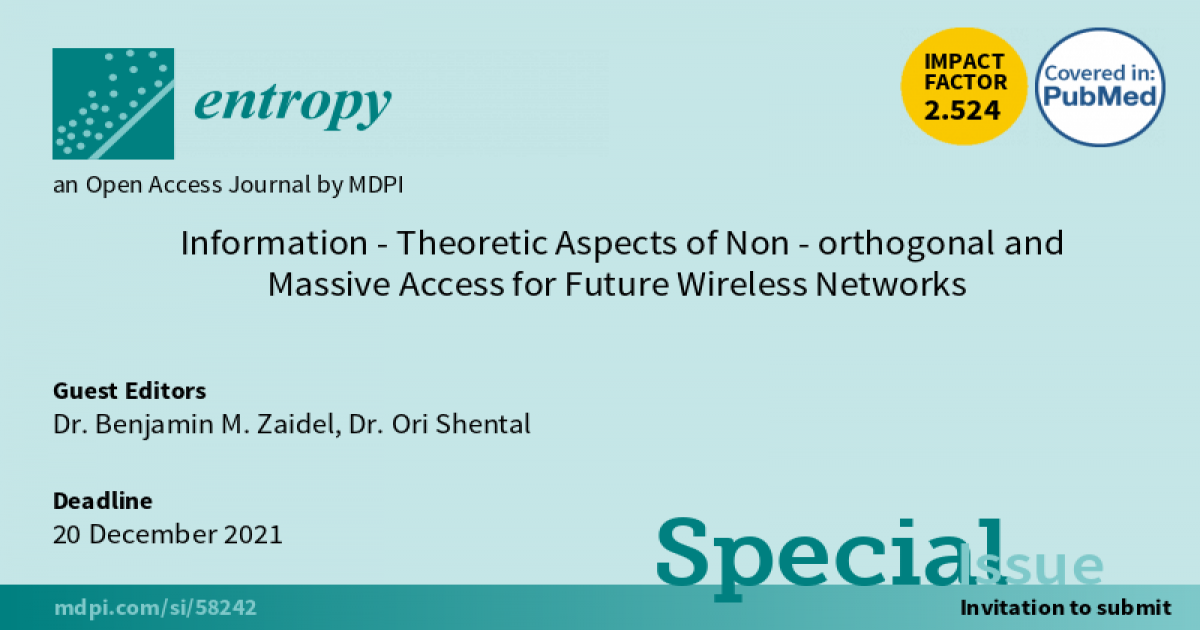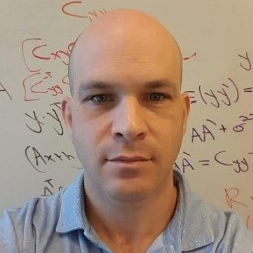Information-Theoretic Aspects of Non-orthogonal and Massive Access for Future Wireless Networks
A special issue of Entropy (ISSN 1099-4300). This special issue belongs to the section "Information Theory, Probability and Statistics".
Deadline for manuscript submissions: closed (20 December 2021) | Viewed by 14954

Special Issue Editors
Interests: information theory; wireless communications; random matrix theory; statistical mechanics; MIMO techniques; cellular communication
Special Issue Information
Dear Colleagues,
The vision for future wireless networks encompasses a wide variety of applications, featuring dramatically higher throughputs as well as massive machine-type communications. It manifests the evolution from human-centric communications, through the current epoch of “internet-of-things” (IoT), to the era of “internet-of-everything” (IoE) expected to evolve during the next decade. This motivates a paradigm shift from legacy orthogonal multiple access (OMA) to non-orthogonal multiple access (NOMA), where the number of simultaneously active users exceeds the number of available time–frequency–space resources. Information-theoretic analyses of NOMA schemes have been a fruitful ground for research in recent years; however, a full comprehension of the fundamental performance limits of the envisioned use-cases is still lacking. Obviously, classical Shannon-type approaches to deriving key performance measures, such as the achievable spectral efficiency, remain useful and of clear interest in certain settings. Nevertheless, some key features of massive machine-type communications may require new paradigms more suitable for the specific characteristics of such settings. In particular, the focus has seemed to shift to new scaling laws for the number of users, code blocklengths, and number of receiving antennas. Moreover, alternative performance measures, such as the recently introduced message-length capacity and per-user probability of error (PUPE), may be essential to a more insightful analytical foundation. In this framework, the notion of “massive access” has been recently considered as an alternative to the classical multiple-access channel setting. Essentially, the massive access model lets the number of active users scale with the blocklength and facilitates analysis of the impact of finite (and short) code blocklengths due to stringent delay constraints, user burstiness, and connectivity larger by orders of magnitude than in classical settings. This Special Issue aims to present a broad information-theoretic perspective of the state-of-the-art of non-orthogonal and massive access research and invites authors to present recent advances in the field that shed light on the challenges ahead in the design of future wireless networks.
This Special Issue solicits unpublished original papers and comprehensive reviews on topics including, but not limited to:
- performance limits of NOMA and massive access;
- low-complexity transceiver design for code-domain and power-domain NOMA;
- techniques for coordinated/uncoordinated (unsourced) and grant-based/grant-free multiple access;
- message-passing algorithms and sparse graph models for efficient NOMA and massive access;
- finite blocklength and URLLC aspects in NOMA and massive access;
- machine learning and data-aided aspects in NOMA and massive access design;
- incorporating MIMO and massive MIMO with NOMA and massive access;
- methods for active user identification in massive access, including machine learning and compressed-sensing-based techniques;
- coding and modulation schemes designed for NOMA and massive access;
- leveraging new advances in wireless communications, such as reconfigurable intelligent surfaces (RIS) and orbital angular momentum (OAM), to bolster multiple access; and
- privacy and security aspects of NOMA and massive access.
Dr. Benjamin M. Zaidel
Dr. Ori Shental
Guest Editors
Manuscript Submission Information
Manuscripts should be submitted online at www.mdpi.com by registering and logging in to this website. Once you are registered, click here to go to the submission form. Manuscripts can be submitted until the deadline. All submissions that pass pre-check are peer-reviewed. Accepted papers will be published continuously in the journal (as soon as accepted) and will be listed together on the special issue website. Research articles, review articles as well as short communications are invited. For planned papers, a title and short abstract (about 100 words) can be sent to the Editorial Office for announcement on this website.
Submitted manuscripts should not have been published previously, nor be under consideration for publication elsewhere (except conference proceedings papers). All manuscripts are thoroughly refereed through a single-blind peer-review process. A guide for authors and other relevant information for submission of manuscripts is available on the Instructions for Authors page. Entropy is an international peer-reviewed open access monthly journal published by MDPI.
Please visit the Instructions for Authors page before submitting a manuscript. The Article Processing Charge (APC) for publication in this open access journal is 2600 CHF (Swiss Francs). Submitted papers should be well formatted and use good English. Authors may use MDPI's English editing service prior to publication or during author revisions.
Keywords
- information theory
- signal processing
- random matrix theory
- statistical mechanics
- multiple access
- graph theory
Benefits of Publishing in a Special Issue
- Ease of navigation: Grouping papers by topic helps scholars navigate broad scope journals more efficiently.
- Greater discoverability: Special Issues support the reach and impact of scientific research. Articles in Special Issues are more discoverable and cited more frequently.
- Expansion of research network: Special Issues facilitate connections among authors, fostering scientific collaborations.
- External promotion: Articles in Special Issues are often promoted through the journal's social media, increasing their visibility.
- e-Book format: Special Issues with more than 10 articles can be published as dedicated e-books, ensuring wide and rapid dissemination.
Further information on MDPI's Special Issue polices can be found here.







